Abstract
GPI-linked surface molecules have recently been described as structures with an activation potential for human T lymphocytes. To study the role of these molecules in T cell activation we analysed GPI-deficient or normal T cells from patients with paroxysmal nocturnal haemoglobinuria (PNH). On activation with allogeneic Epstein-Barr virus (EBV)-transformed B cell lines GPI-deficient freshly separated T cells or continuously growing T cell lines exhibited a significantly lower proliferation or cytokine production compared with their normal counterparts. In contrast, stimulation via the T cell receptor-associated CD3 structure resulted in a comparable response. There was no difference in activation of normal T lymphocytes when GPI-deficient B cells were used as stimulators compared with normal B cells obtained from the same PNH patient. We conclude from these data that GPI deficiency in PNH leads to a functional deficiency of GPI-deficient T cells. In contrast, no difference in activation of T lymphocytes for GPI-deficient cells on the stimulator cell level was observed.
Full text
PDF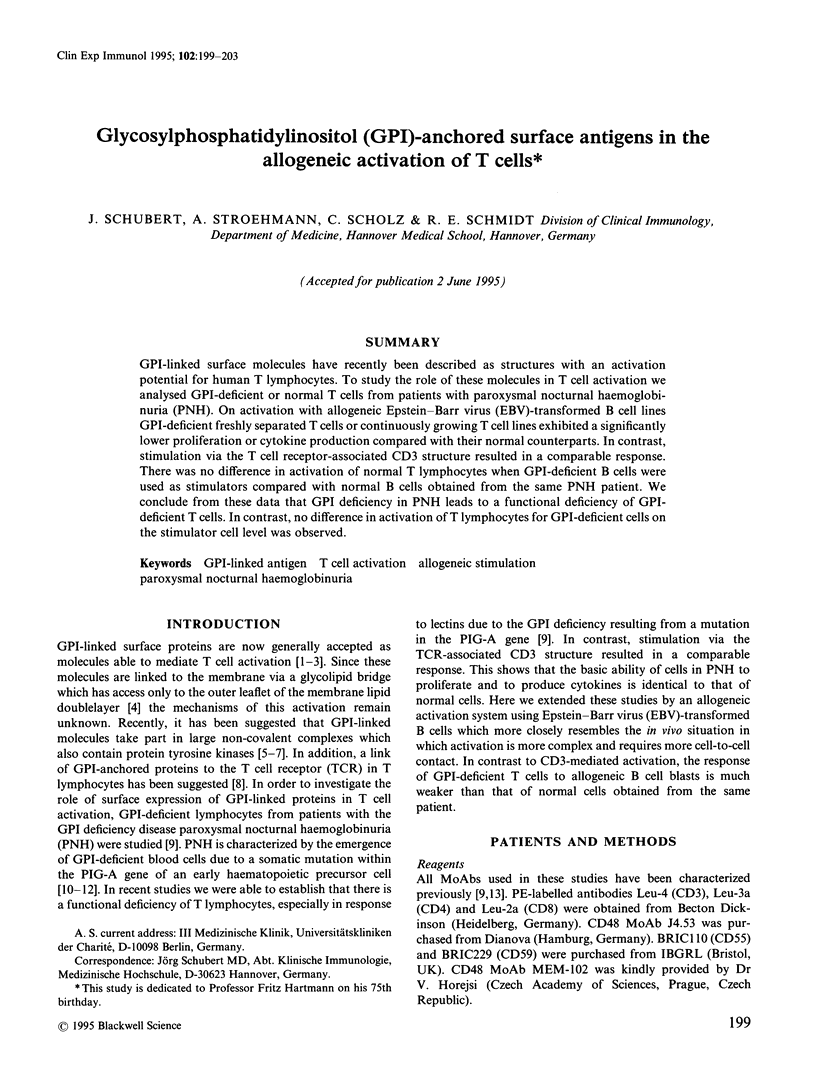
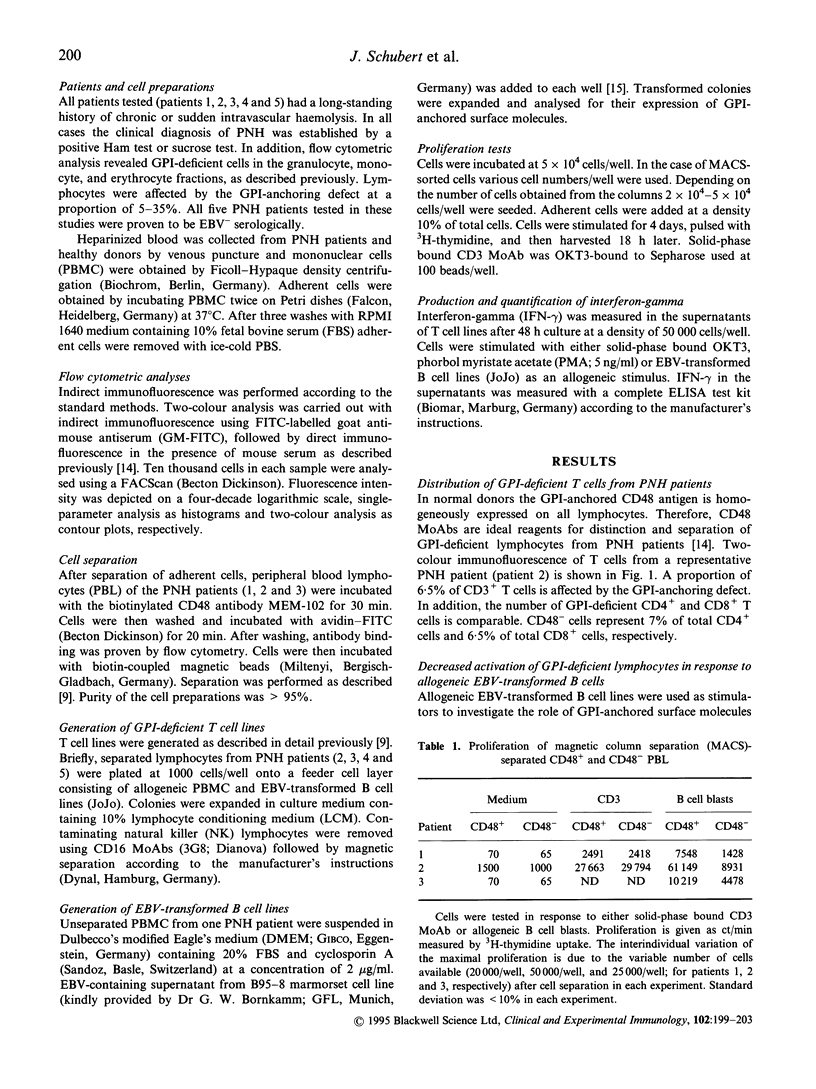
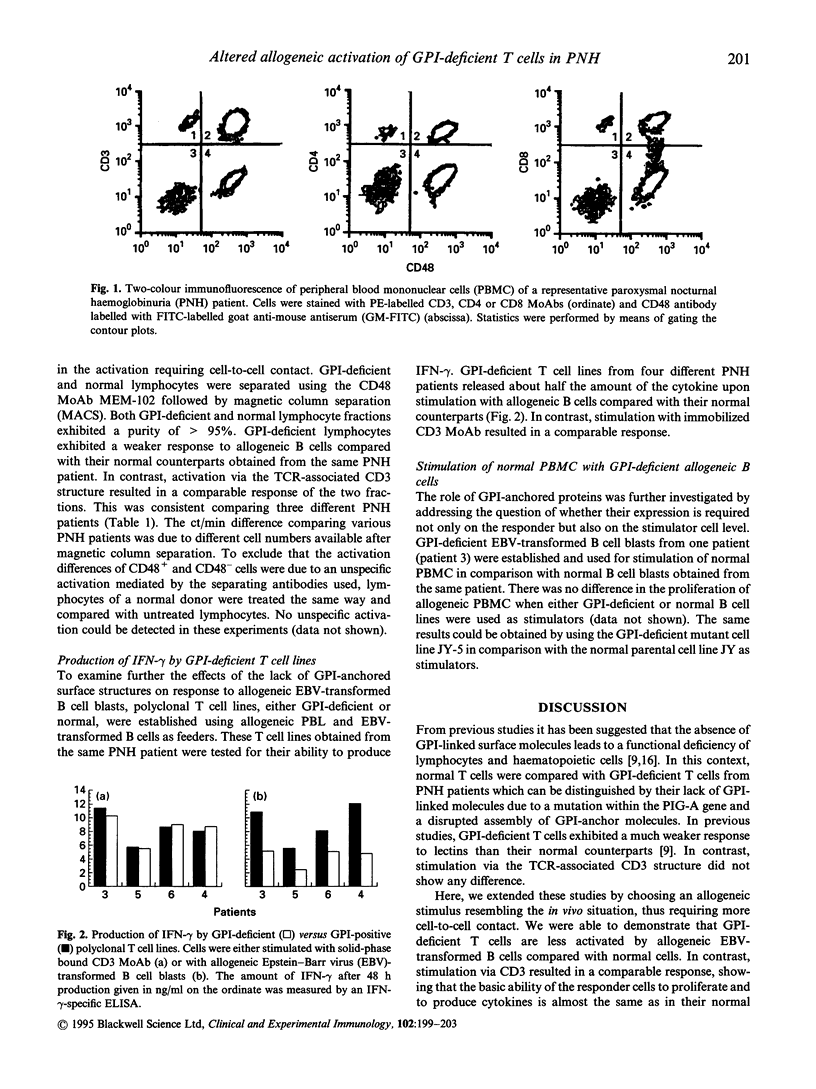
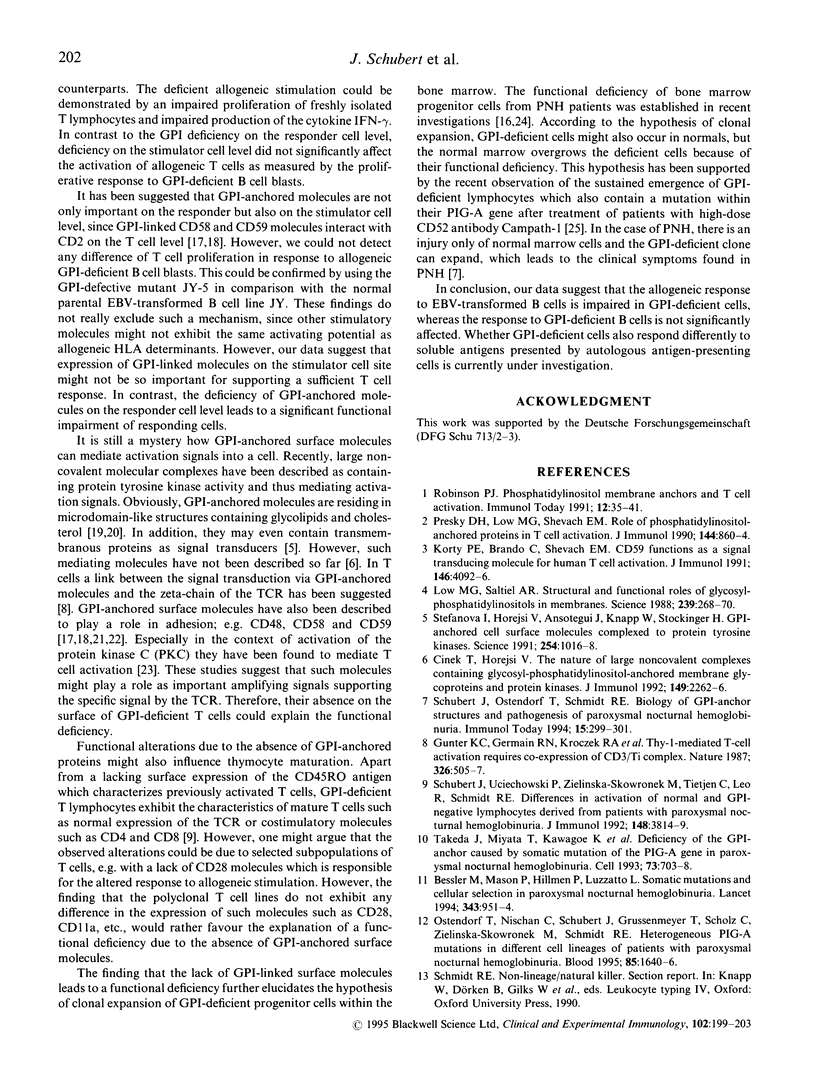
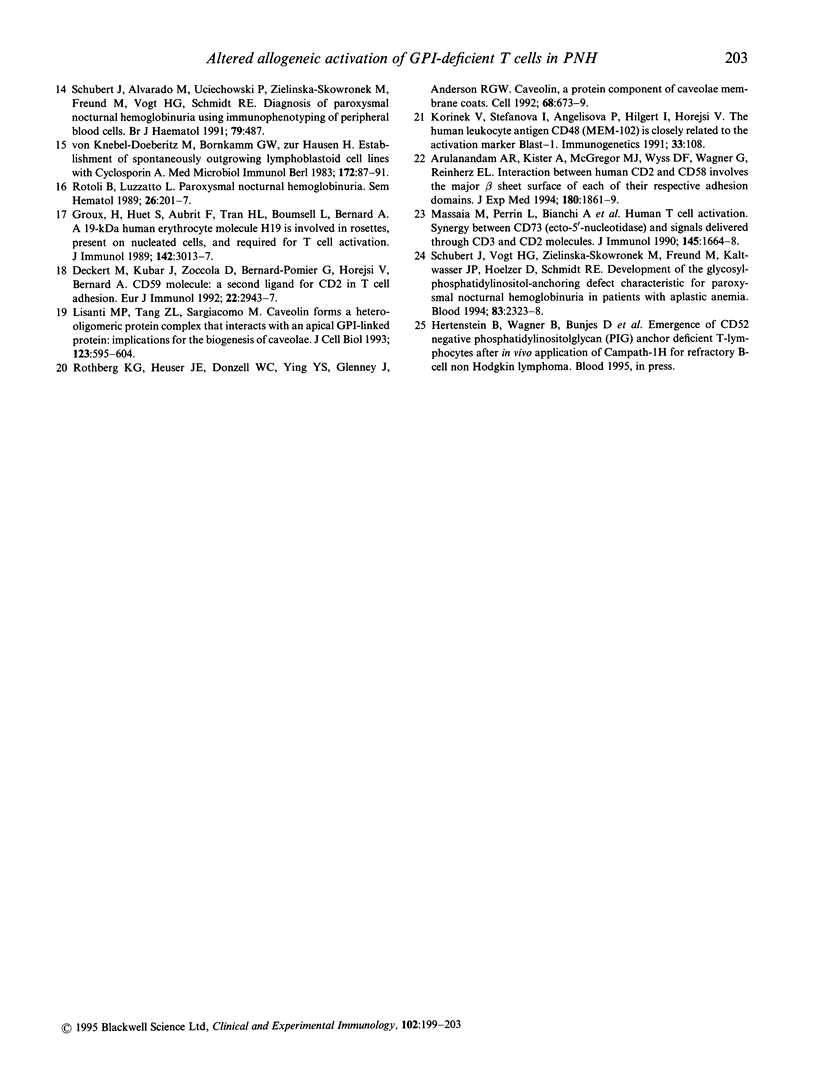
Selected References
These references are in PubMed. This may not be the complete list of references from this article.
- Arulanandam A. R., Kister A., McGregor M. J., Wyss D. F., Wagner G., Reinherz E. L. Interaction between human CD2 and CD58 involves the major beta sheet surface of each of their respective adhesion domains. J Exp Med. 1994 Nov 1;180(5):1861–1871. doi: 10.1084/jem.180.5.1861. [DOI] [PMC free article] [PubMed] [Google Scholar]
- Bessler M., Mason P., Hillmen P., Luzzatto L. Somatic mutations and cellular selection in paroxysmal nocturnal haemoglobinuria. Lancet. 1994 Apr 16;343(8903):951–953. doi: 10.1016/s0140-6736(94)90068-x. [DOI] [PubMed] [Google Scholar]
- Cinek T., Horejsí V. The nature of large noncovalent complexes containing glycosyl-phosphatidylinositol-anchored membrane glycoproteins and protein tyrosine kinases. J Immunol. 1992 Oct 1;149(7):2262–2270. [PubMed] [Google Scholar]
- Deckert M., Kubar J., Zoccola D., Bernard-Pomier G., Angelisova P., Horejsi V., Bernard A. CD59 molecule: a second ligand for CD2 in T cell adhesion. Eur J Immunol. 1992 Nov;22(11):2943–2947. doi: 10.1002/eji.1830221128. [DOI] [PubMed] [Google Scholar]
- Groux H., Huet S., Aubrit F., Tran H. C., Boumsell L., Bernard A. A 19-kDa human erythrocyte molecule H19 is involved in rosettes, present on nucleated cells, and required for T cell activation. Comparison of the roles of H19 and LFA-3 molecules in T cell activation. J Immunol. 1989 May 1;142(9):3013–3020. [PubMed] [Google Scholar]
- Gunter K. C., Germain R. N., Kroczek R. A., Saito T., Yokoyama W. M., Chan C., Weiss A., Shevach E. M. Thy-1-mediated T-cell activation requires co-expression of CD3/Ti complex. Nature. 1987 Apr 2;326(6112):505–507. doi: 10.1038/326505a0. [DOI] [PubMed] [Google Scholar]
- Korty P. E., Brando C., Shevach E. M. CD59 functions as a signal-transducing molecule for human T cell activation. J Immunol. 1991 Jun 15;146(12):4092–4098. [PubMed] [Google Scholar]
- Korínek V., Stefanová I., Angelisová P., Hilgert I., Horejsí V. The human leucocyte antigen CD48 (MEM-102) is closely related to the activation marker Blast-1. Immunogenetics. 1991;33(2):108–112. doi: 10.1007/BF00210823. [DOI] [PubMed] [Google Scholar]
- Lisanti M. P., Tang Z. L., Sargiacomo M. Caveolin forms a hetero-oligomeric protein complex that interacts with an apical GPI-linked protein: implications for the biogenesis of caveolae. J Cell Biol. 1993 Nov;123(3):595–604. doi: 10.1083/jcb.123.3.595. [DOI] [PMC free article] [PubMed] [Google Scholar]
- Low M. G., Saltiel A. R. Structural and functional roles of glycosyl-phosphatidylinositol in membranes. Science. 1988 Jan 15;239(4837):268–275. doi: 10.1126/science.3276003. [DOI] [PubMed] [Google Scholar]
- Massaia M., Perrin L., Bianchi A., Ruedi J., Attisano C., Altieri D., Rijkers G. T., Thompson L. F. Human T cell activation. Synergy between CD73 (ecto-5'-nucleotidase) and signals delivered through CD3 and CD2 molecules. J Immunol. 1990 Sep 15;145(6):1664–1674. [PubMed] [Google Scholar]
- Ostendorf T., Nischan C., Schubert J., Grussenmeyer T., Scholz C., Zielinska-Skowronek M., Schmidt R. E. Heterogeneous PIG-A mutations in different cell lineages in paroxysmal nocturnal hemoglobinuria. Blood. 1995 Mar 15;85(6):1640–1646. [PubMed] [Google Scholar]
- Presky D. H., Low M. G., Shevach E. M. Role of phosphatidylinositol-anchored proteins in T cell activation. J Immunol. 1990 Feb 1;144(3):860–868. [PubMed] [Google Scholar]
- Robinson P. J. Phosphatidylinositol membrane anchors and T-cell activation. Immunol Today. 1991 Jan;12(1):35–41. doi: 10.1016/0167-5699(91)90110-F. [DOI] [PubMed] [Google Scholar]
- Rothberg K. G., Heuser J. E., Donzell W. C., Ying Y. S., Glenney J. R., Anderson R. G. Caveolin, a protein component of caveolae membrane coats. Cell. 1992 Feb 21;68(4):673–682. doi: 10.1016/0092-8674(92)90143-z. [DOI] [PubMed] [Google Scholar]
- Rotoli B., Luzzatto L. Paroxysmal nocturnal hemoglobinuria. Semin Hematol. 1989 Jul;26(3):201–207. [PubMed] [Google Scholar]
- Schubert J., Alvarado M., Uciechowski P., Zielinska-Skowronek M., Freund M., Vogt H., Schmidt R. E. Diagnosis of paroxysmal nocturnal haemoglobinuria using immunophenotyping of peripheral blood cells. Br J Haematol. 1991 Nov;79(3):487–492. doi: 10.1111/j.1365-2141.1991.tb08060.x. [DOI] [PubMed] [Google Scholar]
- Schubert J., Ostendorf T., Schmidt R. E. Biology of GPI anchors and pathogenesis of paroxysmal nocturnal hemoglobinuria. Immunol Today. 1994 Jul;15(7):299–301. doi: 10.1016/0167-5699(94)90074-4. [DOI] [PubMed] [Google Scholar]
- Schubert J., Uciechowski P., Zielinska-Skowronek M., Tietjen C., Leo R., Schmidt R. E. Differences in activation of normal and glycosylphosphatidylinositol-negative lymphocytes derived from patients with paroxysmal nocturnal hemoglobinuria. J Immunol. 1992 Jun 15;148(12):3814–3819. [PubMed] [Google Scholar]
- Schubert J., Vogt H. G., Zielinska-Skowronek M., Freund M., Kaltwasser J. P., Hoelzer D., Schmidt R. E. Development of the glycosylphosphatitylinositol-anchoring defect characteristic for paroxysmal nocturnal hemoglobinuria in patients with aplastic anemia. Blood. 1994 Apr 15;83(8):2323–2328. [PubMed] [Google Scholar]
- Stefanová I., Horejsí V., Ansotegui I. J., Knapp W., Stockinger H. GPI-anchored cell-surface molecules complexed to protein tyrosine kinases. Science. 1991 Nov 15;254(5034):1016–1019. doi: 10.1126/science.1719635. [DOI] [PubMed] [Google Scholar]
- Takeda J., Miyata T., Kawagoe K., Iida Y., Endo Y., Fujita T., Takahashi M., Kitani T., Kinoshita T. Deficiency of the GPI anchor caused by a somatic mutation of the PIG-A gene in paroxysmal nocturnal hemoglobinuria. Cell. 1993 May 21;73(4):703–711. doi: 10.1016/0092-8674(93)90250-t. [DOI] [PubMed] [Google Scholar]
- von Knebel Doeberitz M., Bornkamm G. W., zur Hausen H. Establishment of spontaneously outgrowing lymphoblastoid cell lines with Cyclosporin A. Med Microbiol Immunol. 1983;172(2):87–99. doi: 10.1007/BF02124509. [DOI] [PubMed] [Google Scholar]


